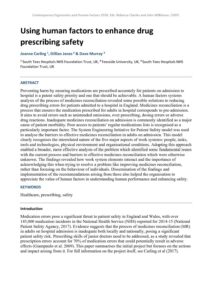| Document | Author Joanne Carling, Gillian Janes & Dave Murray |
| Abstract Preventing harm by ensuring medications are prescribed accurately for patients on admission to hospital is a patent safety priority and one that should be achievable. A human factors systems analysis of the process of medicines reconciliation revealed some possible solutions to reducing drug prescribing errors for patients admitted to a hospital in England. Medicines reconciliation is a process that ensures the medication prescribed for adults in hospital corresponds to pre-admission. It aims to avoid errors such as unintended omissions, over prescribing, dosing errors or adverse drug reactions. Inadequate medicines reconciliation on admission is commonly identified as a major cause of patient morbidity. Poor access to patients’ regular medications lists is recognised as a particularly important factor. The System Engineering Initiative for Patient Safety model was used to analyse the barriers to effective medicines reconciliation in adults on admission. This model clearly recognises the interrelated nature of the five major aspects of work systems: people, tasks, tools and technologies, physical environment and organisational conditions. Adopting this approach enabled a broader, more effective analysis of the problem which identified some fundamental issues with the current process and barriers to effective medicines reconciliation which were otherwise unknown. The findings revealed how work system elements interact and the importance of acknowledging this when trying to resolve a problem like improving medicines reconciliation, rather than focusing on the behaviour of individuals. Dissemination of the findings and implementation of the recommendations arising from these also helped the organisation to appreciate the value of human factors in understanding human performance and enhancing safety. |

